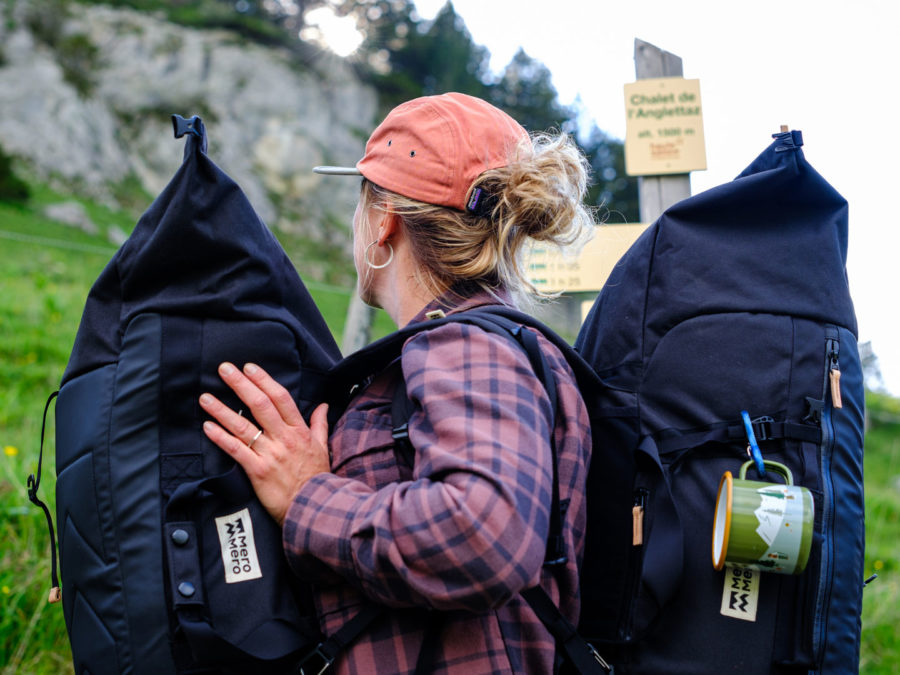Where are MeroMero products made?
All our products are “eco”-designed in France, and more specifically in our Annecy office. We’re fortunate to be located in a very active area, where many companies have also made their “home”. In fact, we are a member of the Outdoor Sport Valley network, which brings together all the companies in the outdoor industry in the Auvergne Rhône-Alpes region. For manufacturing, we work almost daily with our partner in Vietnam. We work a lot by video, email and even WhatsApp to develop prototypes and prepare for production. Once a year, we travel to Vietnam to finalize prototypes and develop new products.
Where are MeroMero products made?
After manufacturing exclusively in France and Europe for the first production run (2016), at the end of 2018 we decided to work with a Japanese partner, located in Vietnam. It’s the only solution we’ve found to continue offering you products that are both technical, eco-responsible and at an acceptable price. Our bags and accessories are made by a Japanese supplier based north of Ho Chi Minh, in southern Vietnam. We chose them because they specialize in technical products: paragliding sails and harnesses, climbing harnesses, camping furniture and backpacks. We tell you all about it on our Responsible Manufacturing page. We don’t hesitate to work with other brands in the outdoor industry to pool certain production costs, raw material purchases, transport of goods or logistics… But whenever possible, we try to find partners in France and Europe for products that are “easier” to manufacture.
Where do the materials come from?
It’s hard to say that 100% of the materials used in our bags are eco-responsible (what does eco-responsible mean in the first place?). In any case, when we select a new fabric, buckles, leather or labels, we ask for the “most responsible” solutions possible for equivalent technicality. In other words: REACH, sustainable, recycled and certified (Bluesign® or OekoTex®). If it fits in the budget, we don’t even ask the price of the conventional equivalent. If it doesn’t (which is often the case, but less and less), we compromise. But with each evolution, our products use more and more materials that respect people and the environment. The main material is now 100% recycled nylon with Bluesign® certification and PFC-free water-repellent treatment, the lining is 100% recycled nylon with our own print, as are the assembly threads (100% recycled nylon), the leather comes from a tannery certified GOLD by the Leather Working Group (LWG), the buckles are made of recyclable aluminum, the cotton is OekoTex® certified or made of Tencel® like the changing mat sheet… The next step will be to optimize the seams, foams, etc., so as to be able to certify the entire product.
What is the REACH regulation?
The REACH regulation is imposed by the European Union to protect human health and the environment from the risks associated with chemical substances. All the components in our products are REACH-certified, which means they have been tested and registered with the European Chemicals Agency (ECHA) to guarantee their non-harmfulness. To find out more, visit the official REACH website.
What is the OekoTex® label?
OEKO-TEX (or ÖKO-TEX) is an independent German label that guarantees the human-ecological qualities of textiles, i.e. those that contain no or very few products toxic to health, skin and the environment. We work first and foremost with OekoTex®-labeled suppliers to guarantee the healthiest, most environmentally-friendly products (textiles, leather, zips, etc.). What’s more, most of the fabrics used in our products are “class I”, i.e. safe for babies’ delicate skin. To find out more, visit the official OekoTex® website.
What is the Bluesign® label?
Bluesign® is an independent Swiss label that has been in existence for over 20 years. It is a comprehensive system that covers the manufacturing processes of both raw materials and finished products, with particular emphasis on chemical substances. Bluesign guarantees the highest level of assurance to consumers in terms of resource use and impact on people and the environment. They are based on five principles: consumer safety, atmospheric emissions, water emissions, occupational health and safety, and resource productivity. Please note that there are several levels of certification: “Bluesign approved fabric” or “Bluesign approved accessories”, which certify a fabric or accessory (buckle, etc.) only. This is the first step before certification of an entire product as a “Bluesign Product”. For this, 90% of fabrics must be Bluesign certified and 30% of accessories. That’s what we’d like to achieve for our next products.
What is the GOLD label?
It is the highest certification awarded by the Leather Working Group, a multi-stakeholder organization comprising representatives of the leather industry, non-governmental organizations (NGOs) and independent certification bodies. It guarantees the sustainability and environmental and social responsibility of leather production. It takes into account water management, waste management, energy consumption, air quality and the company’s social commitment. We work with ISA supplier TanTec, which owns a tannery in Vietnam, a 2-hour drive from our factory.
Why use leather and not a vegan alternative?
We asked ourselves this question for a long time. And, as always, we chose durability over looks. “Real” leather remains a natural, solid material, ideal for straps and pull tabs. However, it has to be processed in conditions that respect animals, people and the environment. That’s why we work with the ISA TanTec tannery (link https://liteleather.com/), located just 2 hours from the factory. It is classified GOLD, the highest level of certification given by the Leather Working Group. The leather we use is also OekoTex certified. We prefer to use a processed natural material rather than “fake leather” made from petroleum (as is often the case). There are more and more “faux leathers” made from vegetable fibers, but we haven’t yet found the ideal solution to replace the look, feel and longevity of cow leather straps. On the other hand, when it’s not necessary, we don’t use leather.














